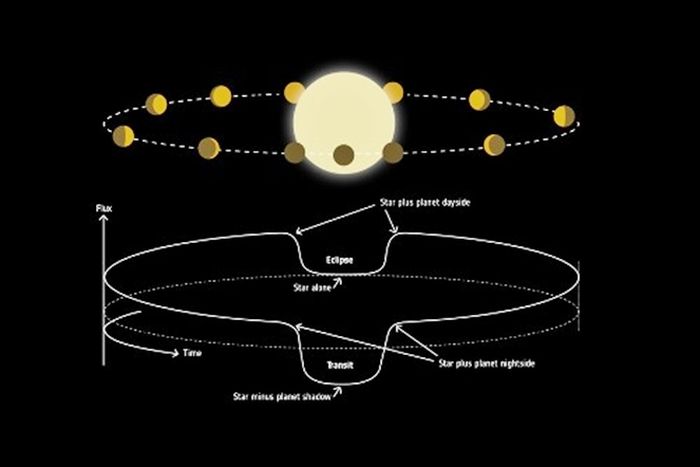Mikal-Evans
–
Illustration of the exoplanet WASP-121 b dubbed ‘Hot Jupiter’.
–
Nationalgeographic.co.id—MIT astronomers have gained the clearest view of the eternal dark side of a planet ekstrasurya which is “tidally locked” to its star. Their observations, combined with measurements of the planet’s permanent day side, provide the first detailed view of an exoplanet’s global atmosphere.
“We’re now moving beyond taking isolated snapshots of certain regions of exoplanet atmospheres, to study them as true 3D systems,” said Thomas Mikal-Evans, who led the research as a postdoc at MIT’s Kavli Institute for Astrophysics and Space Research.
Planets at the center of a new study published February 21, 2022 in Nature Astronomy title Diurnal variations in the stratosphere of the ultrahot giant exoplanet WASP-121b, is an exoplanet named WASP-121b, a gas giant nearly twice the size of Jupiter. This planet is likened to a very hot Jupiter and was discovered in 2015 orbiting a star about 850 light years from Earth. WASP-121b has one of the shortest orbits detected to date, circling its star in just 30 hours. It is also tidally locked, so that its “day” side facing the star roasts permanently, while its “night” side is forever twisted into space.
“Hot Jupiter is known to have a very bright daytime side, but the night side is a different monster. The night side of WASP-121b is about 10 times dimmer than the daytime side,” said Tansu Daylan, a TESS postdoc at MIT who co-authored the study.

European Space Agency
–
This image illustrates how a star illuminates and heats the daytime hemisphere of a tidally locked, orbiting planet.
–
Astronomers have previously detected water vapor and studied how atmospheric temperature changes with altitude on the planet’s day side. The new study captures a much more detailed picture. The researchers were able to map the dramatic temperature changes from day to night, and to see how these temperatures change with altitude. They also tracked the presence of water through the atmosphere, for the first time, how water circulates between the day and night sides of the planet.
While on Earth, water cycles by first evaporating, then condensing into clouds, then rain, but in WASP-121b, the water cycle is much more intense: During the day, the atoms that make up water are torn apart at temperatures above 3,000 Kelvin. These atoms are exhaled to the night side, where cooler temperatures allow hydrogen and oxygen atoms to recombine into water molecules, which are then blown back to the daytime side, where the cycle begins again. The team calculated that the planet’s water cycle is sustained by winds whipping atoms around the planet at speeds of up to 5 kilometers per second, or more than 11,000 miles per hour.
It seems that water is not alone circulating around the planet. Astronomers also discovered that the fairly cold night side harbors exotic clouds of iron and corundum, the minerals that make up rubies and sapphires. These clouds, like water vapor, can rotate to the side during the day, where the high temperatures vaporize the metal into a gaseous state. On the way, exotic rains may be generated, like molten gems from corundum clouds.
Launching Tech Explorist, Dr. Hannah Wakeford of the University of Bristol’s School of Physics said: “We have seen indications of this type of cloud forming in the atmospheres of other planets, but these data suggest that there may be deeper processes on the planet trapping clouds that are beyond our reach. This will have implications for the total energy of the planet and how it transports material around it.”

Max Planck Institute for Astronomy Channel
–
The image depicts measurements obtained with the Hubble Space Telescope to characterize WASP-121 b’s stratosphere.
–
Through spectroscopic studies, scientists have observed atmospheric details on the day side of many exoplanets. But doing the same for the night side is much more difficult, as it requires paying attention to small changes across the planet’s spectrum as it orbits around its star.
In the new study, the team observed WASP-121b over two full orbits — one in 2018, and the other in 2019. In both observations, the researchers looked through the light data for specific lines, or spectral features that indicate the presence of water vapor.
“We looked at these water features and mapped how they changed in different parts of the planet’s orbit,” Mikal-Evans said. “It encodes information about what the temperature of the planet’s atmosphere does as a function of altitude.”
Also Read: This ‘hottest Jupiter’ has the shortest orbit of all the gas giants
Also Read: Astronomers Measure Amount of Carbon and Oxygen in Hot Jupiter’s Atmosphere
Also Read: When the sun goes out, humans should move to Jupiter’s moon
The team did not detect aluminum and titanium in the planet’s atmosphere. They are thought to have condensed and rained down on the deeper layers of the atmosphere, inaccessible for observation. This rain is not as known in the Solar System.
“Despite the discovery of thousands of exoplanets, we were able to study only a small part of the atmosphere due to the challenging nature of observations of the planets. So far, most measurements have provided limited information, such as basic details about the chemical composition or average temperature in a given subregion of the atmosphere.” explained Mikal-Evans.
Wakeford added, “The Hubble Space Telescope is in low-Earth orbit around Earth once every 90 minutes. For this program, we designed it so that we would be pointing at the same target for 26 consecutive Hubble orbits, it’s a very challenging setup, but it has given us tremendous insight into the atmosphere. WASP-121 b.”
Astronomers have also booked time on the James Webb Space Telescope to observe WASP-121b later this year, and hope to map changes to not only water vapor but also carbon monoxide, which scientists think should be in the atmosphere.
“That will be the first time we will be able to measure carbon-carrying molecules in the planet’s atmosphere. The amount of carbon and oxygen in the atmosphere provides clues to where this type of planet formed.” concluded Mikal-Evans.
PROMOTED CONTENT
Featured Videos
–


